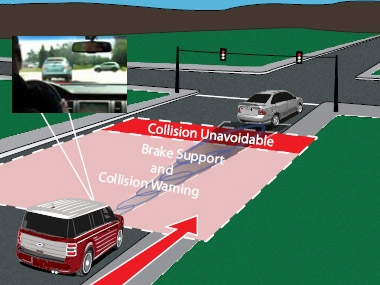06 May 2011 - The auto industry is moving closer to deploying technology into vehicles that could go a long way to making vehicle crashes, at least serious ones, mostly a thing of the past. That's right. The industry that fought against making seat belts standard, is marching toward creating the ultimate safe car without the hammer of regulation coming down on it.
In this case, here're talking about an advanced "intelligent vehicle" safety system that would essentially allow vehicles to "talk" to each other. Car makers have been working on the system for about decade, but engineers say that they could be introduced into production models as early as 2015. Although, it's also possible that it could be more like 2020.
In late January, Ford conducted a demonstration in Washington for journalists and Department of Transportation staffers. And GM's Electronic Networked Vehicle concepts made their North American public debut at the Consumer Electronics Show in Las Vegas, also in January, after spending six months being big attractions at the 2010 World Expo in Shanghai.
And the development of this technology is a team effort, with several carmakers joining forces to shepherd it along. Presently, Ford, GM, Honda, Mercedes, Toyota, Nissan, VW/Audi and Hyundai-Kia are members of a consortium that has set up shop in suburban Detroit, sharing offices, labs and a few garages for their testing. The consortium – dubbed Crash Avoidance Metrics Partnerships (CAMP) -- is funded in part by the Department of Transportation.
As part of the CAMP project, each of the eight carmakers in the consortium will build eight new vehicles equipped with this technology. And another 2,000 vehicles on the road will be retrofitted with the system as part of a test program that will also be partly funded by the DOT.
The intelligent vehicles will essentially use advanced WiFi signals and GPS systems that will send out multiple messages per second to "warn" other drivers – or, the vehicles themselves – of a potential crash. The messages transmit data about the vehicle's location, speed, brakes, steering and other key data that would help the vehicles avoid a collision.
In these intelligent vehicles, the first line of warning would alert the driver. But if the driver does not respond, the system would actually "take over" and apply brakes, or adjust the vehicle's direction.
Primarily, the intelligent-vehicle technology will focus on avoiding collisions by preventing a vehicle from changing lanes, coming up too fast behind a stalled vehicle, or entering an intersection if the light has turned red – or if another driver has run a red light or stop sign.
The system will also detect conditions in problematic situations, like along a curvy road, when a driver cannot visibly detect an oncoming car, or communicate to other drivers that there is black ice on the road.
When the carmakers first began working on the system, the Federal Communications Commission allocated "a specific advanced radio-frequency spectrum for the system to use" explains Mike Shulman, technical leader for Ford Research and Advanced Engineering. "That's a big deal, because spectrum is very valuable.
But the intelligent-vehicle technology has an advantage over radar, says Shulman, in that "it provides 360-degree coverage – it delivers much more information than radar, which is better at measuring distance and velocity. Plus, the cost is relatively low, because it's built off of existing WiFi and GPS technologies."
"We're looking forward to that," says Camp. "We're eager to get people into these intelligent vehicles, so everyone can see them operate in a real-world situation, on real roads – and so that drivers can see how valuable this kind of safety technology can be."


